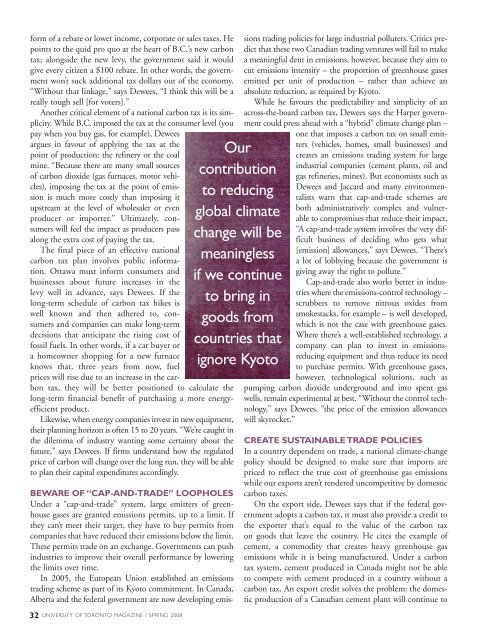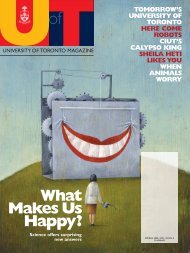20 MB - University of Toronto Magazine
20 MB - University of Toronto Magazine
20 MB - University of Toronto Magazine
- No tags were found...
You also want an ePaper? Increase the reach of your titles
YUMPU automatically turns print PDFs into web optimized ePapers that Google loves.
form <strong>of</strong> a rebate or lower income, corporate or sales taxes. Hepoints to the quid pro quo at the heart <strong>of</strong> B.C.’s new carbontax; alongside the new levy, the government said it wouldgive every citizen a $100 rebate. In other words, the governmentwon’t suck additional tax dollars out <strong>of</strong> the economy.“Without that linkage,” says Dewees, “I think this will be areally tough sell [for voters].”Another critical element <strong>of</strong> a national carbon tax is its simplicity.While B.C. imposed the tax at the consumer level (youpay when you buy gas, for example), Deweesargues in favour <strong>of</strong> applying the tax at thepoint <strong>of</strong> production: the refinery or the coalmine. “Because there are many small sources<strong>of</strong> carbon dioxide (gas furnaces, motor vehicles),imposing the tax at the point <strong>of</strong> emissionis much more costly than imposing itupstream at the level <strong>of</strong> wholesaler or evenproducer or importer.” Ultimately, consumerswill feel the impact as producers passalong the extra cost <strong>of</strong> paying the tax.The final piece <strong>of</strong> an effective nationalcarbon tax plan involves public information.Ottawa must inform consumers andbusinesses about future increases in thelevy well in advance, says Dewees. If thelong-term schedule <strong>of</strong> carbon tax hikes iswell known and then adhered to, consumersand companies can make long-termdecisions that anticipate the rising cost <strong>of</strong>fossil fuels. In other words, if a car buyer ora homeowner shopping for a new furnaceknows that, three years from now, fuelprices will rise due to an increase in the carbontax, they will be better positioned to calculate thelong-term financial benefit <strong>of</strong> purchasing a more energyefficientproduct.Likewise, when energy companies invest in new equipment,their planning horizon is <strong>of</strong>ten 15 to <strong>20</strong> years. “We’re caught inthe dilemma <strong>of</strong> industry wanting some certainty about thefuture,” says Dewees. If firms understand how the regulatedprice <strong>of</strong> carbon will change over the long run, they will be ableto plan their capital expenditures accordingly.32 UNIVERSITY OF TORONTO MAGAZINE / SPRING <strong>20</strong>08Ourcontributionto reducingglobal climatechange will bemeaninglessif we continueto bring ingoods fromcountries thatignore KyotoBEWARE OF “CAP-AND-TRADE” LOOPHOLESUnder a “cap-and-trade” system, large emitters <strong>of</strong> greenhousegases are granted emissions permits, up to a limit. Ifthey can’t meet their target, they have to buy permits fromcompanies that have reduced their emissions below the limit.These permits trade on an exchange. Governments can pushindustries to improve their overall performance by loweringthe limits over time.In <strong>20</strong>05, the European Union established an emissionstrading scheme as part <strong>of</strong> its Kyoto commitment. In Canada,Alberta and the federal government are now developing emissionstrading policies for large industrial polluters. Critics predictthat these two Canadian trading ventures will fail to makea meaningful dent in emissions, however, because they aim tocut emissions intensity – the proportion <strong>of</strong> greenhouse gasesemitted per unit <strong>of</strong> production – rather than achieve anabsolute reduction, as required by Kyoto.While he favours the predictability and simplicity <strong>of</strong> anacross-the-board carbon tax, Dewees says the Harper governmentcould press ahead with a “hybrid” climate change plan –one that imposes a carbon tax on small emitters(vehicles, homes, small businesses) andcreates an emissions trading system for largeindustrial companies (cement plants, oil andgas refineries, mines). But economists such asDewees and Jaccard and many environmentalistswarn that cap-and-trade schemes areboth administratively complex and vulnerableto compromises that reduce their impact.“A cap-and-trade system involves the very difficultbusiness <strong>of</strong> deciding who gets what[emission] allowances,” says Dewees. “There’sa lot <strong>of</strong> lobbying because the government isgiving away the right to pollute.”Cap-and-trade also works better in industrieswhere the emissions-control technology –scrubbers to remove nitrous oxides fromsmokestacks, for example – is well developed,which is not the case with greenhouse gases.Where there’s a well-established technology, acompany can plan to invest in emissionsreducingequipment and thus reduce its needto purchase permits. With greenhouse gases,however, technological solutions, such aspumping carbon dioxide underground and into spent gaswells, remain experimental at best. “Without the control technology,”says Dewees, “the price <strong>of</strong> the emission allowanceswill skyrocket.”CREATE SUSTAINABLE TRADE POLICIESIn a country dependent on trade, a national climate-changepolicy should be designed to make sure that imports arepriced to reflect the true cost <strong>of</strong> greenhouse gas emissionswhile our exports aren’t rendered uncompetitive by domesticcarbon taxes.On the export side, Dewees says that if the federal governmentadopts a carbon tax, it must also provide a credit tothe exporter that’s equal to the value <strong>of</strong> the carbon taxon goods that leave the country. He cites the example <strong>of</strong>cement, a commodity that creates heavy greenhouse gasemissions while it is being manufactured. Under a carbontax system, cement produced in Canada might not be ableto compete with cement produced in a country without acarbon tax. An export credit solves the problem: the domesticproduction <strong>of</strong> a Canadian cement plant will continue to
















